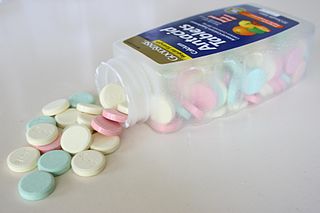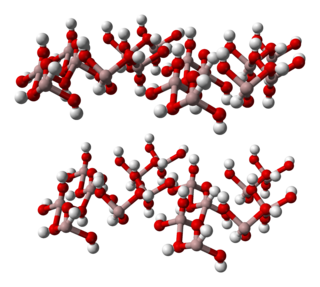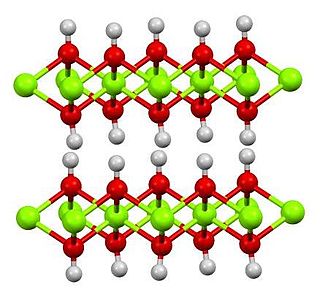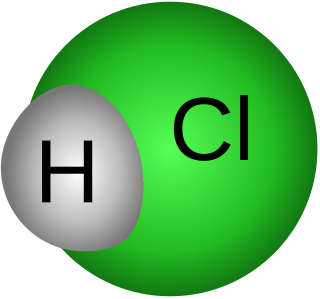
An antacid is a substance which neutralizes stomach acidity and is used to relieve heartburn, indigestion, or an upset stomach. Some antacids have been used in the treatment of constipation and diarrhea. Marketed antacids contain salts of aluminum, calcium, magnesium, or sodium. Some preparations contain a combination of two salts, such as magnesium carbonate and aluminum hydroxide.

Aluminium hydroxide, Al(OH)3, is found in nature as the mineral gibbsite and its three much rarer polymorphs: bayerite, doyleite, and nordstrandite. Aluminium hydroxide is amphoteric, i.e., it has both basic and acidic properties. Closely related are aluminium oxide hydroxide, AlO(OH), and aluminium oxide or alumina, the latter of which is also amphoteric. These compounds together are the major components of the aluminium ore bauxite. Aluminium hydroxide also forms a gelatinous precipitate in water.

Magnesium hydroxide is an inorganic compound with the chemical formula Mg(OH)2. It occurs in nature as the mineral brucite. It is a white solid with low solubility in water (Ksp = 5.61×10−12). Magnesium hydroxide is a common component of antacids, such as milk of magnesia.
Coffee ground vomitus refers to a particular appearance of vomit. Within organic heme molecules of red blood cells is the element iron, which oxidizes following exposure to gastric acid. This reaction causes the vomitus to look black like coffee grounds

Pantoprazole, sold under the brand name Protonix, among others, is a medication used for the treatment of stomach ulcers, short-term treatment of erosive esophagitis due to gastroesophageal reflux disease (GERD), maintenance of healing of erosive esophagitis, and pathological hypersecretory conditions including Zollinger–Ellison syndrome. It may also be used along with other medications to eliminate Helicobacter pylori. Pantoprazole is a proton-pump inhibitor (PPI) and its effectiveness is similar to that of other PPIs. It is available by mouth and by injection into a vein.

Calcium citrate is the calcium salt of citric acid. It is commonly used as a food additive (E333), usually as a preservative, but sometimes for flavor. In this sense, it is similar to sodium citrate. Calcium citrate is also found in some dietary calcium supplements. Calcium makes up 24.1% of calcium citrate (anhydrous) and 21.1% of calcium citrate (tetrahydrate) by mass. The tetrahydrate occurs in nature as the mineral Earlandite.

Famotidine, sold under the brand name Pepcid among others, is a histamine H2 receptor antagonist medication that decreases stomach acid production. It is used to treat peptic ulcer disease, gastroesophageal reflux disease, and Zollinger-Ellison syndrome. It is taken by mouth or by injection into a vein. It begins working within an hour.

Gastritis is the inflammation of the lining of the stomach. It may occur as a short episode or may be of a long duration. There may be no symptoms but, when symptoms are present, the most common is upper abdominal pain. Other possible symptoms include nausea and vomiting, bloating, loss of appetite and heartburn. Complications may include stomach bleeding, stomach ulcers, and stomach tumors. When due to autoimmune problems, low red blood cells due to not enough vitamin B12 may occur, a condition known as pernicious anemia.

Achlorhydria and hypochlorhydria refer to states where the production of hydrochloric acid in gastric secretions of the stomach and other digestive organs is absent or low, respectively. It is associated with various other medical problems.
Altana AG is a German chemical company headquartered in Wesel. It was created in 1977, as a result of spinning off divisions from the Varta Group. The first CEO was Herbert Quandt.

Calcium aluminate cements are cements consisting predominantly of hydraulic calcium aluminates. Alternative names are "aluminous cement", "high-alumina cement", and "Ciment fondu" in French. They are used in a number of small-scale, specialized applications.
Preoperative fasting is the practice of a surgical patient abstaining from eating or drinking for some time before having an operation. This is intended to prevent stomach contents from getting into the windpipe and lungs while the patient is under general anesthesia. The latest guidelines do not support preoperative fasting, as there is no difference in residual gastric fluid volume, pH or gastric emptying rate following semi-solid meals or drinks, whether in obese or lean individuals.

Cinitapride (trade names Cintapro, Pemix) is a gastroprokinetic agent and antiemetic agent of the benzamide class which is marketed in India, Mexico, Pakistan and Spain. It acts as an agonist of the 5-HT1 and 5-HT4 receptors and as an antagonist of the 5-HT2 receptors.
Proton pump inhibitors (PPIs) block the gastric hydrogen potassium ATPase (H+/K+ ATPase) and inhibit gastric acid secretion. These drugs have emerged as the treatment of choice for acid-related diseases, including gastroesophageal reflux disease (GERD) and peptic ulcer disease. PPIs also can bind to other types of proton pumps such as those that occur in cancer cells and are finding applications in the reduction of cancer cell acid efflux and reduction of chemotherapy drug resistance.

Aceglutamide, or aceglutamide aluminium, also known as acetylglutamine, is a psychostimulant, nootropic, and antiulcer agent that is marketed in Spain and Japan. It is an acetylated form of the amino acid L-glutamine, the precursor of glutamate in the body and brain. Aceglutamide functions as a prodrug to glutamine with improved potency and stability.
Etomoxir, or rac-Ethyl 2-[6-(4-chlorophenoxy)hexyl]oxirane-2-carboxylate, in form of the dextrorotatory (R)-(+)- enantiomer, is an irreversible inhibitor of carnitine palmitoyltransferase-1 on the inner face of the outer mitochondrial membrane. The actual inhibitor – (R)-(+)-etomoxir-Coenzym A ester – is formed in an intracellular process. The middle inhibitor concentration for the inhibition of the CPT-1 in the liver, heart, and muscle mitochondria of rats lies in between 5 and 20 nmol/l, depending on the animal's state of metabolism. (+)-Etomoxir is a colourness solid with a melting point of 38 °C (311 K). The sodium salt of (+)-Etomoxir is water-soluble. The (S)-(-)-enantiomer of Etomoxir does not block CPT-1.
BYK is a globally operating supplier of additives and measuring instruments.

Lotrifen, also known as trazisoquine and sold under the brand names Canocenta and Privaprol, is an abortifacient which is used in veterinary medicine. It was described in 1978.

Acid peptic diseases, such as peptic ulcers, Zollinger-Ellison syndrome, and gastroesophageal reflux disease, are caused by distinct but overlapping pathogenic mechanisms involving acid effects on mucosal defense. Acid reflux damages the esophageal mucosa and may also cause laryngeal tissue injury, leading to the development of pulmonary symptoms.
Byk is a Slavic surname. The word literally means "bull". Notable people with the surname include:













